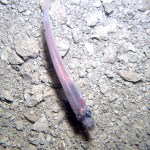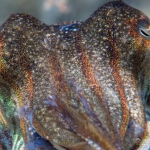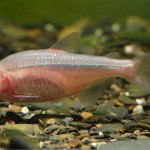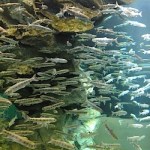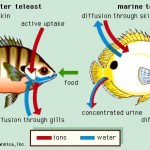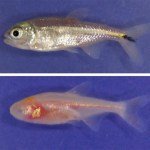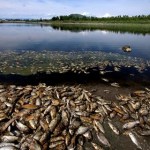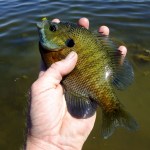fish
A fish found swimming under 740 meters of ice. Credit: Reed Scherer (NIU)
An unexpected find and very exciting moment for researchers exploring what lies beneath 740 meters of ice in Antarctica...fish! An amazing find given the perpetual darkness and cold.
In an expedition sponsored by the National Science Foundation, scientists and ice drillers bored a hole through the Ross Ice Shelf near the coast of Antarctica, 850 kilometers from the closest place where there is sunlight. The area is known as the grounding zone, which is in essence a subglacial beach. According to a quote from glacial…
Few fish can survive the immense pressure of living in the deep sea. The Mariana Trench can reach around 36,200 feet deep with pressures of over 1,000 atmosphere. Scientists have placed landers at various depths ranging from 16,400-34,750 feet along the walls of the trench and have discovered what appears to be the "World's Deepest Fish". The fish was found at 26,872 feet which is estimated to be near the lower limit for bony fishes (of 27,600 feet). This newly discovered fish has what look like wings and tentacles. The video below was captured by the Hadal Ecosystem Studies expedition (HADES…
Last June (and May and July and part of August) we had a lot of precipitation in Minnesota. This caused lake levels to rise modestly. One lake, which is large enough to have meaningful waves, has older settlement along it so lots of cabins, boat houses, and such are right on the shoreline. With the lake level up, waves threatened the material possessions of rich white people, so naturally something had to be done. A No-Wake Rule was put into effect.
A No-Wake Rule means the oversized fishing boats and smallish cabin cruisers that normally ply this large exurban lake need to all go at 5 m…
Image from the American Physiological Society's website.http://www.the-aps.org/mm/Conferences/APS-Conferences/2014-Conferences/…
Tuesday was no less exciting than Monday!
Here are some highlights:
I thoroughly enjoyed a session called "Overcoming a Major Physiological Barrier: Adaptation from Saline to Freshwater Habitats" which highlighted the need for several species to shift how they regulate ion balance when they migrate between fresh water (ion absorption from the water) and salt water (ion secretion to the water).
Clements K, Bojarski L, Johnson K, McMillan S, White L, Angert E (Univ…
Image from the American Physiological Society's website.http://www.the-aps.org/mm/Conferences/APS-Conferences/2014-Conferences/…
As anticipated, the meeting today was excellent! Here are some highlights from today:
Dr. Michael Joyner (Mayo Clinic) spoke about how we should reconsider animal models that are used in research as laboratory rodents can be manipulated to match their genotype to their phenotype. In other words, researchers modify the animal's genome to produce a specific disease or attribute they are interested in studying. The problem with this approach is that genes can be…
Image of eyeless Mexican tetra fish from www.seriouslyfish.com by H-J Chen.
The metabolism of most animals follows a circadian rhythm that differs between the day and night. Mexican cavefish living in constant darkness, lost this circadian rhythm some time ago. In a newly published study in PLOS ONE, researchers compared the metabolic rate of both cave- and surface-dwelling Mexican tetra fish (Astyanax mexicanus). They hypothesized that since the fish living in each location naturally experience differences in food, predation as well as exposure to daily light fluctuations, they might also…
No joke. George (the goldfish) had developed a rather large tumor over the past year and the owners loved the fish so much, they spent $200 to have the life-threatening tumor surgically removed:
Conservationists are trying hard to save the Devils Hole pupfish (Cyprinodon diabolis) from extinction. With less than 100 animals remaining, a captive breeding program was started at the University of California, Berkeley.
As you can imagine from the image below, the geographic range of this fish is smaller than other wild vertebrates. They are only found in the limestone caverns of the geothermal Devils Hole pool in Death Valley, Nevada. The pool is 3m wide, 20m long, 426 feet deep, and a very warm 92-93 degrees Fahrenheit. It is thought to have formed more than 500,000 years ago…
Image of Biwa salmon from the Lake Biwa Museum (http://www.lbm.go.jp/english/exhibits/aquarium.html)
It is not surprising that Biwa salmon (image above), a subspecies of Oncorhyncus masou, do not adapt to seawater very well after having been landlocked in Lake Biwa, Japan for the last 500,000 years or so. Researchers from Hokkaido University and Shiga Prefecture Fishery Experiment Station in Japan wanted to know what caused the salmon to lose their ability to thrive in salt water. In a new paper published in the American Journal of Physiology they compared the…
Freshwater fish are in a constant battle with their environment when it comes to maintaining their electrolyte balance as they are continuously losing ions to the surrounding water. Therefore, they have to actively absorb ions such as sodium, calcium and chloride from the water (see figure below). Prior research has shown that acidic environments cause adult and larva zebrafish to increase sodium uptake from their environment.
Depiction of water and salt homeostasis in freshwater and marine fish.
Researchers Kumai et al (University of Ottowa, Ontario, Canada) have provided evidence to…
Sounds kind of like an oxymoron doesn't it? Who knew sponges could be carnivorous? Scientists have described four new species of carnivorous sponges in a newly published article in Zootaxa. Check out this video from the lead author of the study, Lonny Lundsten who is a Senior Research Technician at the Monterey Bay Aquarium Research Institute:
Lundsten L, Reiswig HM, Austin WC. Four new species of Cladorhizidae (Porifera, Demospongiae, Poecilosclerida) from the Northeast Pacific. Zootaxa. 3786 (2): 101–123, 2014.
Image from LiveScience. Credit: Richard Borowsky
Heat shock protein 90 (HSP90) helps keep proteins in the body folded properly and is thought to compensate for variations that occur in proteins over time. In a study published in Science magazine, Dr. Nicolas Rohner and colleagues showed that stress can affect the ability for HSP90 to do its job thereby unmasking these alternative versions of proteins which may lead to adaptation in some cases.
The theory was tested in fish called Mexican tetra (above), some of which adapted to life in caves leading to eventual loss of, or diminished,…
Dr. Carl Meyer (University of Hawaii) and Dr. Katsufumi Sato (University of Tokyo) have teamed up to gather data about shark behavior in a rather interesting way. They flipped the animals upside down, which makes them relax, and strapped on cameras and instruments that will facilitate the creation of 3D models of shark movements. Using accelerometers, they are able to measure speed while magnetometers record the magnetic field and additional tools measure the water temperature and depth. The video is used to help contextualize these other data.
Sources:
University of Hawaii
National…
I came across this interesting video today from Animal Wire that shows a population of catfish caught hunting pigeons on land:
Who knew that catfish had more in common with cats than just their whiskers.
I'm sure that several years ago a bunch of out of work "oceanographers" like the people here got board and started faking various "fish" that only they ever saw in the wild and only they ever photographed and that lived in the "deep" ocean where nobody could verify their existence. I assume this was a funny joke that got out of hand and now they're stuck with having to come up with a new "fish" every so often to keep up the ruse. Here's the latest, a fish with a see-through head:
For the first time, a large Pacific barreleye fish - complete with transparent head - has been caught on film by…
A guide from the Catalina Island Marine Institute discovered the carcass of an oarfish (Regalecus glesne) off the coast of Catalina Island this week. Oarfish are the longest bony fish (reports up to ~50 feet long) in the ocean. Because oarfish live deep in the ocean, there have been limited studies on their physiology or behavior. So this was quite the exciting find!
Other Sources:
LiveScience
233,000 gallons of molasses has leaked from a pipeline near the shore of Honolulu suffocating thousands of fish. The pipeline is used to load molasses onto ships. Officials have warned people to stay out of the water as sharks may be attracted to the area. The Hawaii Department of Health is working on removing the dead fish and cleaning up this environmental disaster.
This is funny:
Just so you know, he was not fishing for "bluegills" This is a bluegill:
A nice bluegill
Bluegills live in fresh water and are like "sunfish" and "pumpkinseeds" and "crappies" etc. all of which are in the bass family.
Bluefish live in the ocean and roam along littoral regions in large schools. This is what large bluefish look like:
Of course, when one is fishing for bluefish, there is always the possibility of catching the fish that eats them, such as striped bass. Like this:
The striped bass is not in the "bass family" referred to above. Striped Bass are Moronidae,…
Image of common model organisms from European Molecular Biology Laboratory (EMBL).
A recent article posted in the BBC News provided a good explanation of why scientists commonly study these organisms as models for human diseases and conditions. Model organisms are chosen because their physiology is similar to other animals, including humans, in addition to other reasons:
Visit the BBC News to see why researchers most often use flies, fish, mice and worms to understand the mechanisms of disease and health.
Did you know that ~70% of the genes in a…
Trace amounts of oxazepam in rivers has large effects on wild perch. Image credit: Brent Christensen
Dr. Tomas Brodin (Umea University, Sweden) and colleagues have discovered that trace amounts of the drug oxazepam that ends up in rivers and streams (from toilets) greatly effects local fish. The drug is used to treat anxiety in humans and also calms fish. However, for wild perch, which normally hunt in schools, the antisocial effects of the drug in fish makes them more vulnerable to predation.
Psychiatric medications are not the only…
